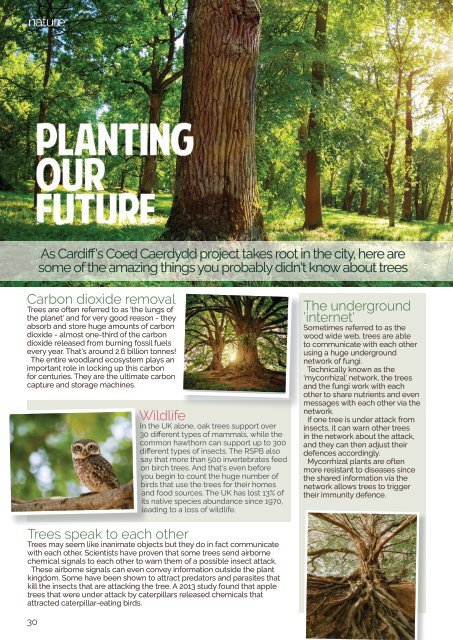Rhiwbina Living
Summer 2023 issue of Rhiwbina Living, the award-winning magazine for Rhiwbina.
Summer 2023 issue of Rhiwbina Living, the award-winning magazine for Rhiwbina.
- TAGS
- wales
- whitchurch
- rhiwbina
- cardiff
Create successful ePaper yourself
Turn your PDF publications into a flip-book with our unique Google optimized e-Paper software.
nature<br />
As Cardiff's Coed Caerdydd project takes root in the city, here are<br />
some of the amazing things you probably didn't know about trees<br />
Carbon dioxide removal<br />
Trees are often referred to as 'the lungs of<br />
the planet' and for very good reason - they<br />
absorb and store huge amounts of carbon<br />
dioxide - almost one-third of the carbon<br />
dioxide released from burning fossil fuels<br />
every year. That's around 2.6 billion tonnes!<br />
The entire woodland ecosystem plays an<br />
important role in locking up this carbon<br />
for centuries. They are the ultimate carbon<br />
capture and storage machines.<br />
Wildlife<br />
In the UK alone, oak trees support over<br />
30 different types of mammals, while the<br />
common hawthorn can support up to 300<br />
different types of insects. The RSPB also<br />
say that more than 500 invertebrates feed<br />
on birch trees. And that's even before<br />
you begin to count the huge number of<br />
birds that use the trees for their homes<br />
and food sources. The UK has lost 13% of<br />
its native species abundance since 1970,<br />
leading to a loss of wildlife.<br />
The underground<br />
'internet'<br />
Sometimes referred to as the<br />
wood wide web, trees are able<br />
to communicate with each other<br />
using a huge underground<br />
network of fungi.<br />
Technically known as the<br />
‘mycorrhizal’ network, the trees<br />
and the fungi work with each<br />
other to share nutrients and even<br />
messages with each other via the<br />
network.<br />
If one tree is under attack from<br />
insects, it can warn other trees<br />
in the network about the attack,<br />
and they can then adjust their<br />
defences accordingly.<br />
Mycorrhizal plants are often<br />
more resistant to diseases since<br />
the shared information via the<br />
network allows trees to trigger<br />
their immunity defence.<br />
Trees speak to each other<br />
Trees may seem like inanimate objects but they do in fact communicate<br />
with each other. Scientists have proven that some trees send airborne<br />
chemical signals to each other to warn them of a possible insect attack.<br />
These airborne signals can even convey information outside the plant<br />
kingdom. Some have been shown to attract predators and parasites that<br />
kill the insects that are attacking the tree. A 2013 study found that apple<br />
trees that were under attack by caterpillars released chemicals that<br />
attracted caterpillar-eating birds.<br />
30

















